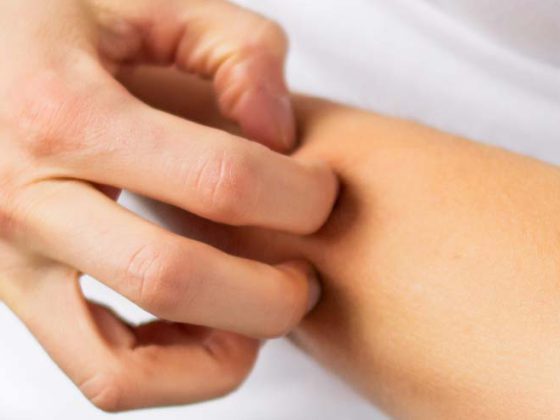Occupational eczema is one of the most common occupational diseases. Irritant hand eczema typically occurs initially with wet work. They can be precursors for allergic eczema. Occupational contact dermatitis is often caused by epoxy resins. Sensitization to the preservative methylisothiazolinone is currently frequent and still increasing. In the case of all employees with an occupational disease and a significant risk if they continue to work, the Suva Occupational Medicine Department is responsible for assessing suitability and, if necessary, for issuing a non-suitability order.
In recent years, occupational dermatoses accounted for about 20% of recognized occupational diseases in Switzerland. This makes dermatoses the second most common recognized occupational disease after noise-induced hearing loss and apparently the most common occupational disease related to the current
Workplace. In addition, the number of unreported cases is likely to be considerable. Hand eczema due to occupational and non-occupational causes is one of the most common diagnoses of all, and occupational contact eczema is also clearly the most common form of occupational dermatoses. In general practice, the differential diagnosis of scaly skin lesions on the hands should distinguish between eczema, mycosis and psoriasis. Whereas mycosis is often only pronounced on one side and can be easily clarified by microscopic examination and culture of skin scales, the differentiation of psoriasis often causes greater problems, even with histological examination of the skin. This makes a thorough physical examination with evidence of psoriasis in typical skin areas all the more important.
Exogenous or endogenous causes
In hand eczema, a distinction must be made between exogenous and endogenous causes, and in the former between allergic and irritant genesis. The most common endogenous hand eczemas are atopic and “idiopathic” dyshidrotic eczema (Fig. 1). As our own experience and investigations, for example in Germany, have shown, in many chronic hand eczemas an overlapping of irritative and allergic mechanisms and atopic skin diathesis can be demonstrated. In this context, the exact delineation of the various causative factors is difficult, even in the context of an expert opinion.
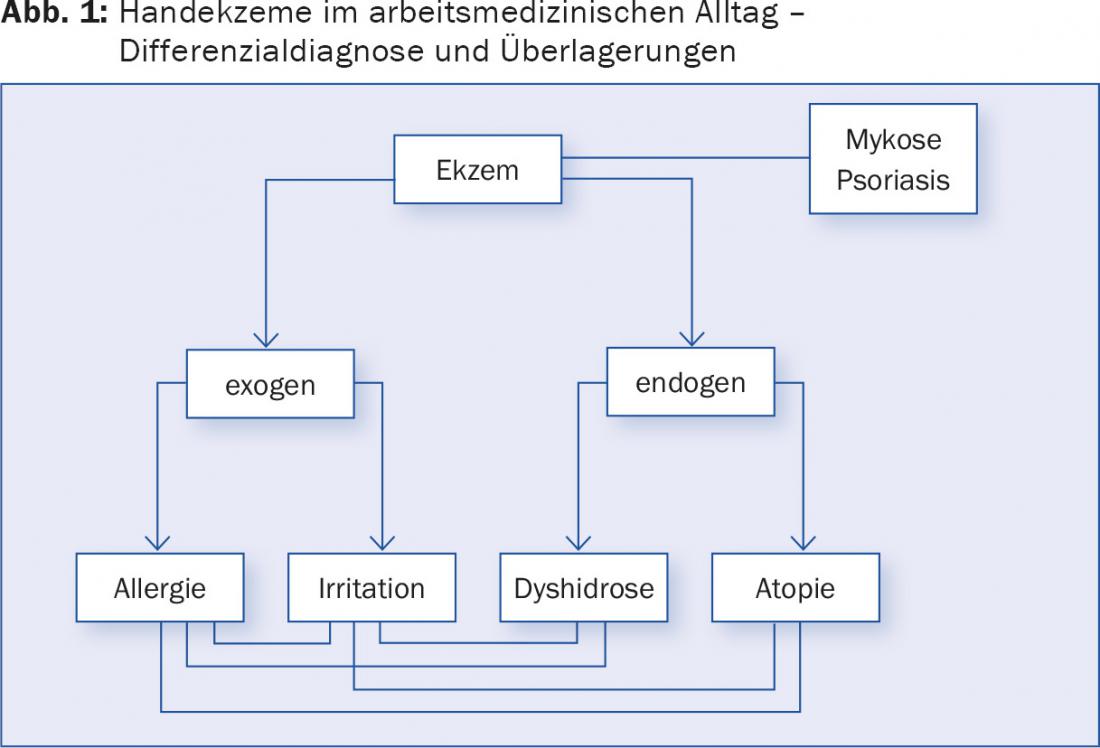
In everyday working life, the toxic or harmful substances in particular come into play. irritant contact dermatitis (the terms are usually used as synonyms) is common. While acute toxic eczema can occur after a single exposure to a correspondingly aggressive substance, cumulative toxic contact eczema develops only after prolonged exposure to intrinsically weak irritants or combined exposures. The latter form of eczema often requires a detective approach in the clarification in order to analyze and break the chain of causes together with the patient. These include adverse exposures such as repetitive wet work, mechanical damage, occlusion, frequent hand washing and hand disinfection (Table 1).
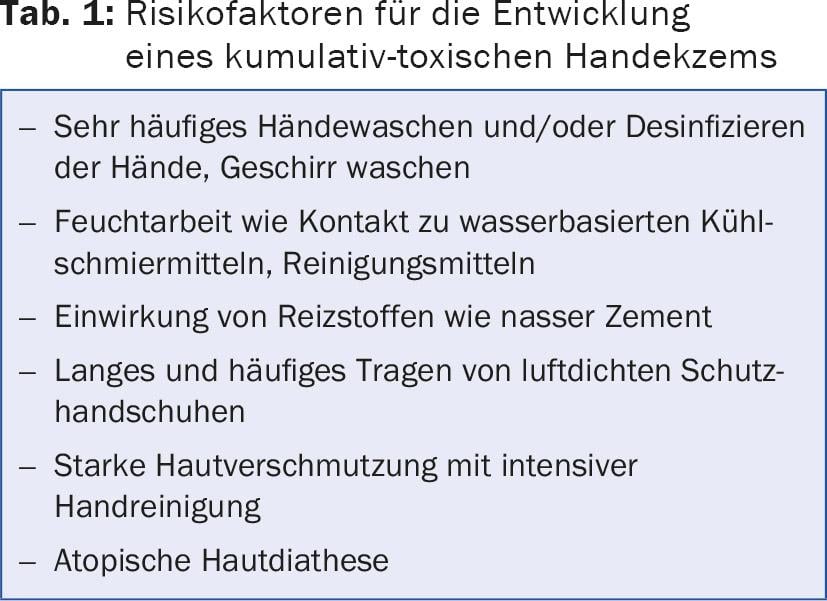
Allergic contact dermatitis is much less common than toxic contact dermatitis. Nevertheless, the registered allergic skin damage cases in accident insurances correspond numerically to the toxic ones. This can probably be explained by the better identification of the harmful substances and, in individual cases, by the compulsion to avoid certain activities in the case of proven allergy. Allergic contact dermatitis usually manifests after weeks, months or even years of contact with sensitizing agents. Severe itching, blistering and often oozing of the skin are characteristic. Upon re-exposure to the allergen, a new eczema flare-up occurs rapidly in each case. For longer resp. Repeated exposure to the allergen may later result in an inherent course of eczema.
Contact eczema due to epoxy resins
In Switzerland, allergic contact eczema caused by epoxy resins in the occupational environment has been the most frequent occurrence for years (Fig. 2). These eczemas are often severe and typically manifest after only a short exposure. In recurrences, it is not uncommon for uncovered areas of the body to be affected, e.g., upper arms, neck, and face (Fig.3). Most often, the prognosis is favorable if exposure is strictly avoided. Because of the severity of recurrences, a nonfitness order is usually indicated where workplace exposure is unavoidable. Since epoxy resins are often used in two-component systems, it is advisable to ask in the case of two-component systems not only explicitly about “epoxy resins”, a rather abstract term, but specifically about two-component systems with mixing of resin and hardener in the case history, because this is often better known to the persons concerned [1].
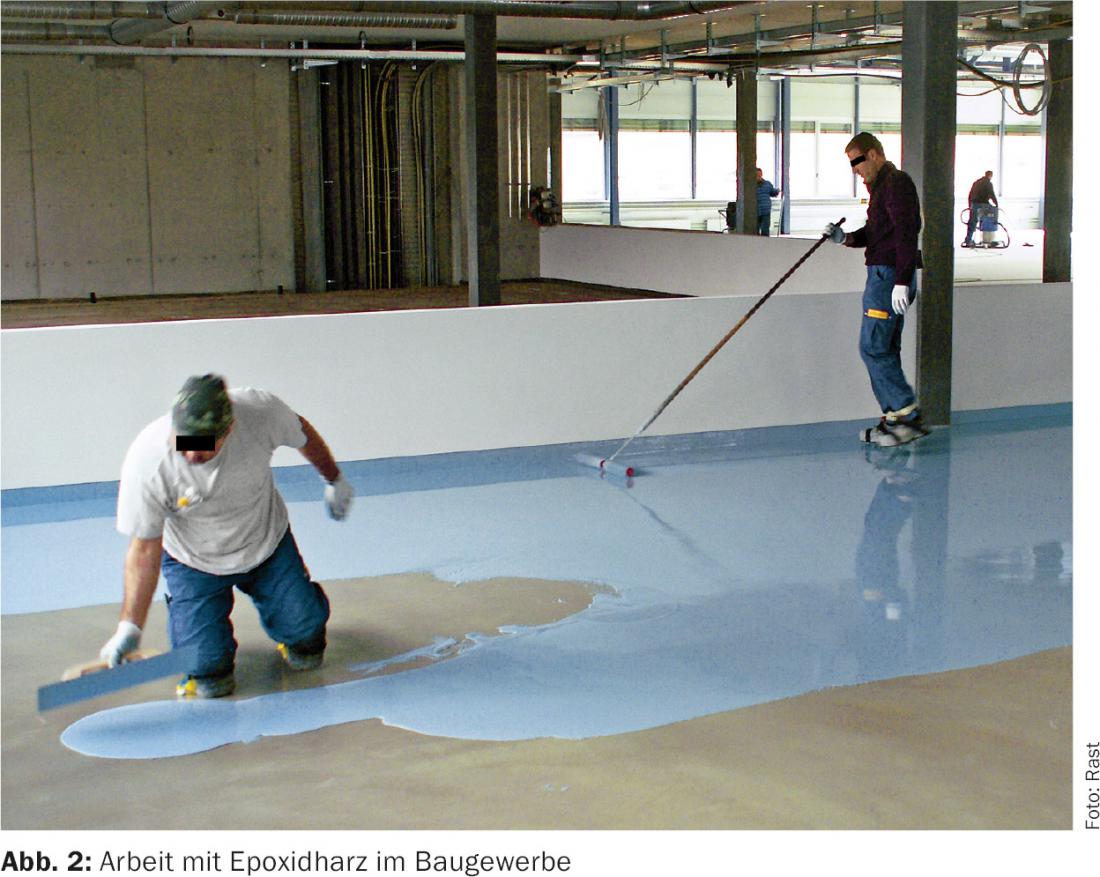
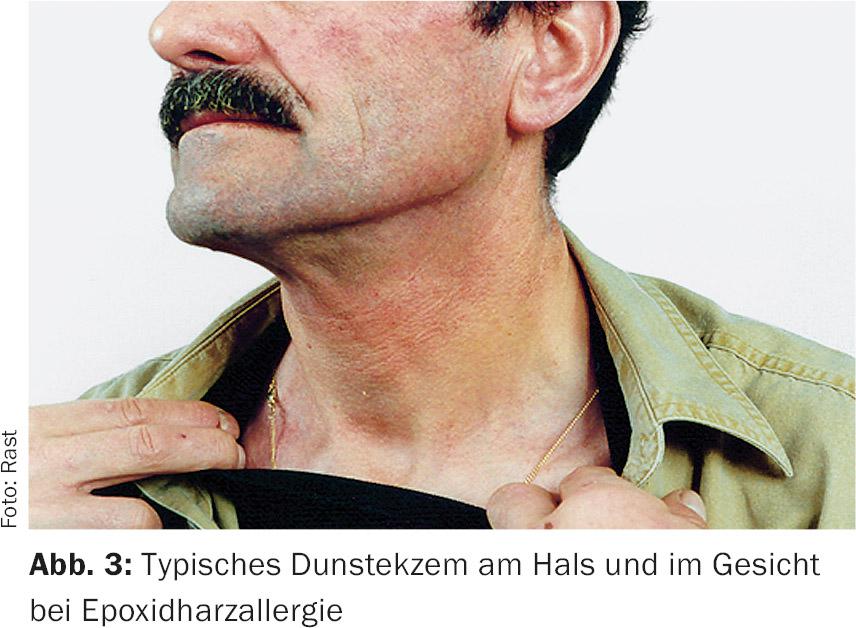
Excema caused by hair care products, cement or preservatives.
For employees in the hairdressing industry, where we often initially toxic resp. observe irritant eczema due to wet work, contact allergies may develop with prolonged occupational exposure, usually to hair dyes and bleach. In that case, a non-suitability order is often unavoidable.
Until a few years ago, allergic cement eczema was one of the most common occupational allergies. Since the main sensitizing ingredients (chromium salts) have been converted into a less sensitizing form by legal requirement, hardly any allergic cement eczema is observed.
An increase in sensitization to the preservative methylisothiazolinone is currently being observed throughout Europe, and in some European countries it is even the “allergen hit”. This additive can lead to sensitization, especially in cosmetics and many cleaning agents that are also used in the household, but occasionally also triggers occupationally relevant contact eczema in painters and employees in hairdressing, massage and cosmetics.
Procedure for occupational dermatosis
In occupational dermatoses, the diagnosis can be substantially narrowed with a focused history and clinical findings. If there is a reasonable suspicion of occupational dermatosis, the affected person should be asked to register with the relevant accident insurance company via the employer. Both the employer and the employee are responsible for reporting.
The attending physicians can also send such a report directly to the accident insurance company with the consent of the insured person. It should be noted that Suva, as the largest accident insurer by law, primarily insures industrial companies, the construction and stone trades, federal companies, and transport and forestry professions. Other accident insurance companies are responsible for most service companies. Employees in the hairdressing trade, in small bakeries, in hospitals, in the catering trade and agriculture are therefore generally not insured with Suva. All insurers are guided by the requirements of the Accident Insurance Act, which also regulates insurance law issues relating to occupational diseases.
The accident insurance company clarifies the facts of the case through specially trained case workers and field staff, often with the assistance of occupational physicians or occupational hygienists, and comments on whether an occupational disease exists. It is particularly worth mentioning that Suva, unlike the other insurers, is responsible for occupational health care and thus also for the suitability assessment of employees. If an occupational disease poses a significant risk to continued employment, Suva’s occupational medicine department must review continued suitability. The case-leading accident insurance company must therefore forward such cases to Suva.
A non-suitability order or conditional suitability order for certain activities is a measure that, depending on the situation, may require enhanced protective measures in the workplace, an internal transfer or even a change of job. Under certain conditions, a non-suitability order can also lead to integration measures and, in the case of significant loss of earnings, to transitional benefits [2]. The insured person must register with the IV in order for retraining to be considered. Concerning diagnosis and treatment of occupational eczema, especially with stepwise therapy, a consensus paper of Swiss dermatologists is available [3].
Skin protection
In case of contact with typical allergens and in all activities mentioned as causes of toxic contact dermatitis, skin protection measures should be initiated in the workplace. In addition to technical and organic measures, the employer must also provide skin protection agents and protective gloves.
For insured persons with occupational hand eczema, individual consultation regarding skin protection products by the specialist is necessary. Tips on skin hazards and protection can be found on the website www.2haende.ch, which is supported by Suva. In addition to general instructions, information is also provided here about suitable protective gloves. A wide range of skin protection products and protective gloves is offered by the virtual specialty store www.sapros.ch. In some companies, skin protection measures have indeed been introduced and trained. To ensure that they remain anchored in everyday professional life, however, the training courses must be repeated periodically.
More information
Brochure: “Occupational skin diseases”, Suva, Lucerne.
Order number 2869/11 (d and f)
www.suva.ch/hautschutz
www.suva.ch/waswo
www.suva.ch/arbeitsmedizin
(Suva Publications Portal and pdf)
www.unfallstatistik.ch
Literature
- Rast H: Epoxy resins as an occupational dermatological challenge. Suva Medical 2013; 84d: 52-58. Suva order number 2869/84 (d and f).
- Jost M, Rast H: Suitability assessment according to UVG: Non-suitability order/conditional suitability order.
- Ther. Umschau 2007; 64(8): 437-442.
- Ballmer-Weber B, et al: Hand eczema: practical approach to diagnosis and treatment. Schweiz Med Forum 2013; 13(23): 453-458.
HAUSARZT PRAXIS 2015; 10(10): 8-11


